Waterfalls OF MP
Search for Hotels in Madhya Pradesh
Bhoora Khon Waterfall
BhooraKhon waterfall is located in the Shivpuri district of Madhya Pradesh state, India. It is located near the MadhavSagar Lake and has a boat club, a park and a recreation centre for the visitors. The boat club is an ideal place for swimming and having some adventure! During the pre-independent times, the membership in boating teams was taken up at this boat club. A large gathering collected to watch the boat marines, display their water skills. It was also the spot joining the sailing club of the National Park. BhooraKhon is a small water fall, as it descends from a height of 25 meters.
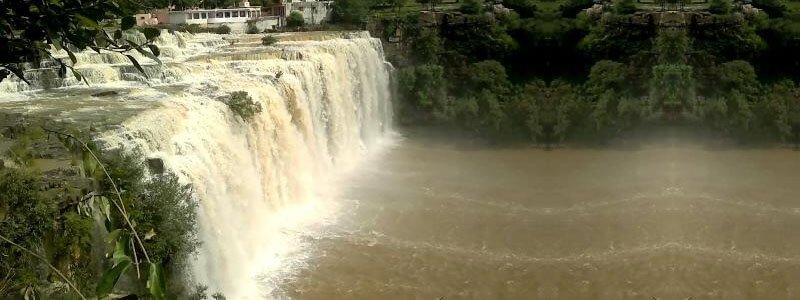
BhooraKhon waterfall has a spiritual attachment to it, as an ancient idol of Lord Shiva is located at this cascade. The waterfall takes a plunge from a short height and merges into the river flowing nearby. BhooraKhon is one of the 3 waterfalls of the Shivpuri district, viz. BhooraKhon waterfall, Pawa waterfall and Sultan Garh waterfall. The ideal time to visit this cascade in its prime is in the months of October to March. The nearest railway station to the falls is Jhansi, at a distance of 92 kilometers from Shivpuri town. All the airports of Madhya Pradesh i.e. Bhopal, Indore, Gwalior, Jabalpur and Khajuraho are well connected with the major cities of India.
The BhooraKhon cascade beckons visitors for calm and a rejuvenating vacation. The small descent of the waters creates a soft roar in the serene environment, tantalizing the senses. BhooraKhon is a beautiful natural waterfall and offers an adventurous hike to the tourists, up the boulders and rocks.
The waters of the BhooraKhon waterfall glitter with the fall of the sun rays on them. The plunging stream takes a short fall, taking breaks at the boulders and rocks lying underneath. At the end of the fall is a small kund, where the visitors can take a dive and enjoy a swimming experience with friends and family!
Tincha Waterfall
Tincha Falls are located in the Indore district of the central Indian state of Madhya Pradesh. They can be accessed from the Indore city, at a distance of 25 kilometers. Tincha Falls are a package deal; it’s a valley, a canyon as well as a gorge, apart from being a marvelous cascade. These falls are placed near the Tincha village, from which it derives its name. They can be visited on the Simrol-Udainagar Road, by taking a small left deviation. Tincha Falls is a famous monsoon destination amongst the tourists, as the beauty of the falls blooms with the advent of rains!
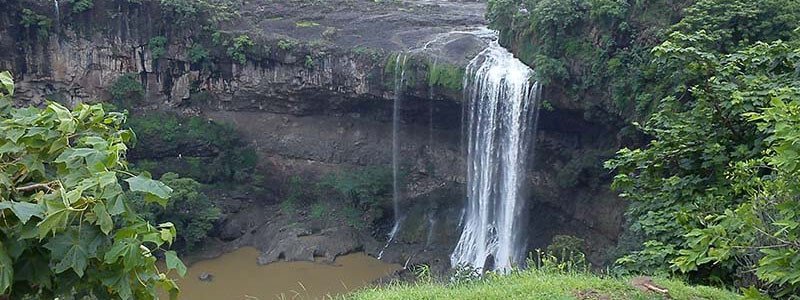
The Tincha falls are quite popular amongst the locals and visitors to MP state. As a result, this place is quite populated during the weekends, while on week days; there is a fairly good crowd. The falls plummet from a height of a whopping 300 feet. Bathing and swimming activities have been prohibited recently, as the visitors do not follow the safety instructions of the authorities. However, there is a pond nearby for water play! There are many trekking tracks, farms and ghats near the falls for nature enthusiasts, photo fanatics, wild wanderers, adventure lovers and above all fun lovers!
The breathtaking panoramic view of the greenery surrounding the Tincha Falls rejuvenates the soul of the visitor. However, one needs to beware of the monkeys around the falls, snatching away detachable items from the tourists! Enjoy corn on the cobs, along with some local fruit vendors selling their wares at the falls. Good roads lead to the Tincha Falls, with no inconvenience to the travelers. The Tincha villagers are hospitable people, eager to help those who need directions. One can easily spend two to three hours at the falls, basking in its beauty. The nearest airport to Tincha Falls is at Indore, at a distance of 2 kilometers and the closest railway station would be Kalachandwithin the same radius.
Dugdh Dhara Waterfall
The DugdhDhara Falls are located near Amarkantak, within the central Indian state of Madhya Pradesh. These serene milky white falls gurgle down the rocks, spraying water on the onlookers. For recreation, the tourists can take a dip in the cool and soothing waters of the river, explore the small caves around the falls, with a statue of a sage in meditation or hike from the Kapildhara falls to the DugdhDhara Falls for adventure. It is advisable to hire a guide or seek help from the locals to explore the area better.
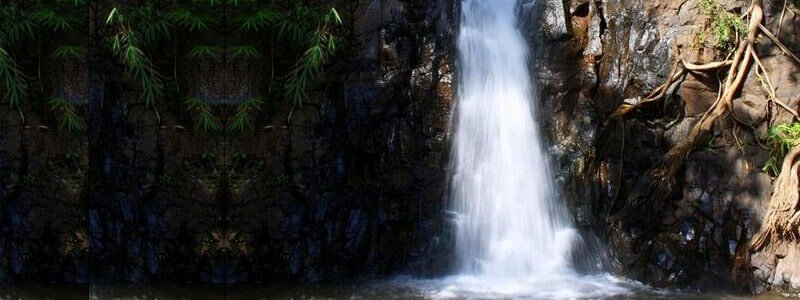
The KapilDhara Falls and the DugdhDhara Falls are just one kilometer apart. A steep down path leads to DugdhDhara from KapilDhara. The height of the DugdhDhara falls is 10 feet, while KapilDhara is higher. The waters of the cascade appear to be of milky white color. Both the falls are originated at the Narmada Kund and the mighty River Narmada plunges down from a great height, gurgling its way through. The location of DugdhDhara Falls is set amongst thick forests, towards the western edge of the Amarkantak valley. One can come across several seasonal streams, post the monsoon season around the cascade.
According to the local tales, backed by Hindu Puranas, Maharishi Durvasa was believed to have meditated by the DugdhDhara Falls. At that time, the cascade was named DurvasaDhara, after the sage. According to another tale, the Holy mother Narmada had made divine presence before the Prince of Rewa in the form of a milk stream, at the current location of DugdhDhara. Henceforth, the falls were named DugdhDhara Falls i.e. the milk stream. The place attracts many children to the falls, as they can play water games and make a small expedition to the caves around or just encounter the wildlife around at times!
The DugdhDhara Falls are surrounded by temples and ashrams, rendering a religious feel to the atmosphere around. These falls can be visited throughout the year; however, the River Narmada is full after the rainy season. Nature lovers and photo fanatics can have a close encounter with nature at its best, at the falls. Spending one to two hours in this serene environment is sufficient to cleanse one’s soul. The nearest railway station to Amarkantak is Jabalpur, at a distance of 193 kilometers. Bilaspur is the closest airport to the vicinity, at a distance of 57 kilometers.
Gangulpara Tank and Waterfall
The Gangulpara Tank and Waterfall is located in the Balaghat district of the central Indian state of Madhya Pradesh. It is at a distance of 14 kilometers from Balaghat. One can discover this waterfall on the Baihar road. It is a marvelous mixture of natural beauty and splendor, feasting the eyes of the onlooker! An ideal picnic spot for the locals, it is frequently visited by them for their weekend getaways. Nature lovers appreciate this water body, which also serves as a storage tank for the waters of GhysriNala. This water reserve fulfills the irrigation needs of the farmers of the local village nearby, Tekadi.
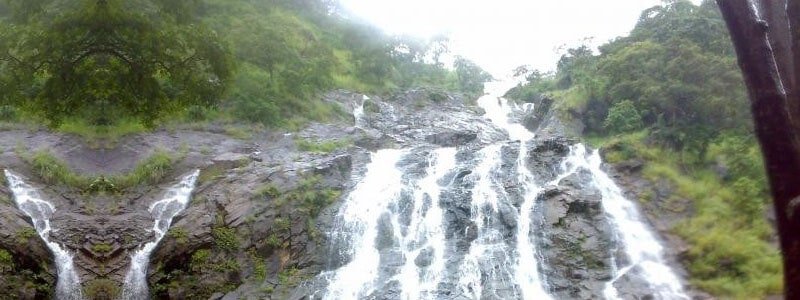
About fall Gangulpara tank and waterfall is part of the Godavari river basin. It was completed as a reservoir in the year 1958. The nearby cities that can be visited along with a trip to Gangulpara waterfall include Mayur Nagar, Gondiya, Goregaon, Rajnandgaon, Durg, Bhilai and Dhamtari.
Chachai Waterfall
The Chachai Falls are located in the Rewa district of the central Indian state of Madhya Pradesh. The height of the falls is a whopping 130 meters, making them the 23rd highest waterfalls in India. They are created by the River Bihad, a tributary of the River Tamsa or Tons, as it is popularly known as. The Chachai falls are a classic example of a nick point, which is caused by rejuvenation. Knick or nick point or casually called as just ‘nick’ is the break in the slopes of the waterfall. The break results in the vertical fall of water, creating a cascade. These falls have a unique water formation.
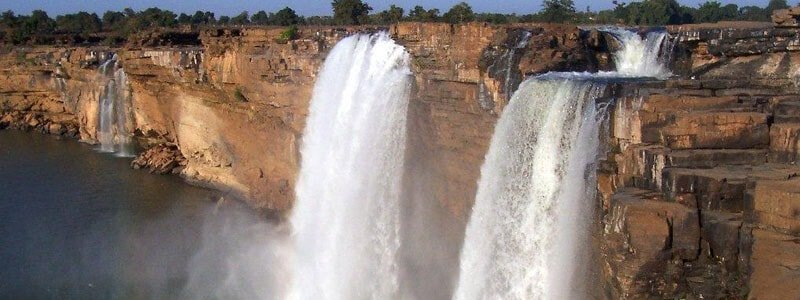
The Chachai falls are the 2nd highest falls in the state of MP. The River Bihad plummets down the Rewa plateau in the form of Chachai Falls. The flow of the river, however, has been reduced by the creation of a dam, for generating electricity for the state and providing irrigation facilities around the falls. The Chachai falls are located at a distance of 46 kilometers from Rewa district. These falls are a part of the Chitrakoot Hills of Kaimur mountain range. Rewa district is famous for its delicious mangoes, roaring white tigers and circling Egyptian vultures around the Chachai Falls.
The Chachai falls are quite dangerous amongst the waterfalls of MP state. Therefore, one must be utmost careful during the visit to Chachai and enjoy its splendor with caution. The post monsoon time is the best time to visit these falls, as the river Bihad is plunging forward with even more rigor at the Chachai falls.
The nearest airport to the Chachai Falls is at Rewa, at a distance of 29 kilometers. The rail accessibility is from Simaria, at a distance of 10 kilometers from Chachai. These falls can easily be reached either from Rewa or Satna. Chachai waterfall is one of the 4 beautiful cascades of the Rewa district. Chachai waterfalls bear resemblance to the Keoti Falls and the Bahuti Falls of MP state. The grand canyon of Chachai falls is visible from a distance, especially when the water flow is low. There are a few rest houses for tourist accommodation near the Chachai Falls and only Rewa Retreat is a hotel in the vicinity.
Gatha Waterfall
Gatha falls are located in the Panna district of the central Indian state of Madhya Pradesh. The height of Gatha fall measures up to 91 meters. As a result, it has been ranked as the 36th highest waterfall in the Indian sub-continent. The roar of the cascade and its mesmerizing beauty lures the travelers from the highway towards its waters. The water descends from low lying hills and hits the ground from a very high level. The Gatha falls are at their prime during the rainy season, when the river water swells to the maximum. River Ken is the water source of Gatha Falls.
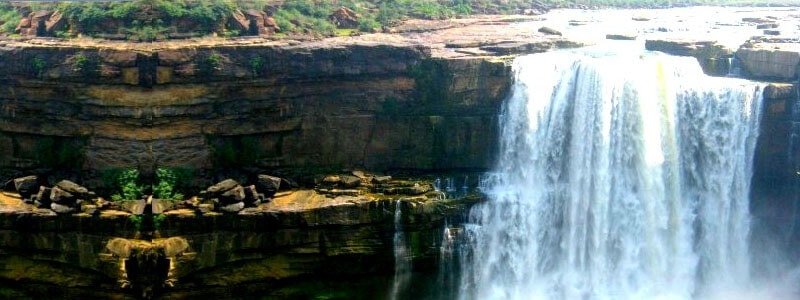
The district of Panna is rich in numerous waterfalls known, along with some unexplored ones too! The landscape is vast and beautiful, due its location in the Vindhyachal range of mountains. One can reach Panna by rail from Jhansi railway station, which is at a distance of 176 kilometers. In fact, Khajuraho airport is even closer to Panna i.e. at a distance of 26 kilometers. Gatha falls are located at a distance of 12 kilometers from Panna district. They are the 5th highest waterfall in the state of MP.
Bahuti Waterfall
The BahutiPrapat or falls lie in the Rewa district of the central Indian state of Madhya Pradesh. A narrow River Odda, tributary of the River Bihad, which in turn is a part of the River Tamsa or Tons (as it is popularly known), travels 65 kilometers from its origin, to reach the edge of the Rewa plateau. It takes a plunge from the plateau from a height of 142 meters. As it reaches the bottom, it joins two other rivers. The other waterfall created in the area, also by the Bihad River is the Keoti waterfall. Chachai falls and Purwa falls are also in close proximity with the Bahuti falls.
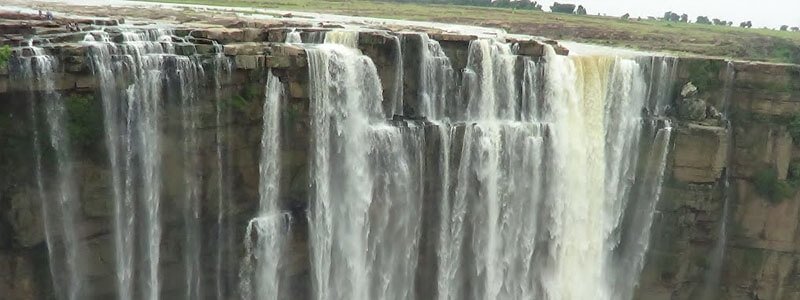
Tallest Waterfall of Madhya Pradesh The Bahuti falls descend from a height of 142 meters, which makes them the highest waterfalls in the state. The waters of the falls beneath are very deep, reaching the depths at 364 feet! The Bahuti falls are a classic example of a nick point, which is caused by rejuvenation. Knick or nick point or casually called as just ‘nick’ is the break in the slopes of the waterfall. The break results in the vertical fall of water, creating a cascade. These falls have a unique water formation. The Bahuti falls are deep, marvelous, rejuvenating, attractive, on the whole, a total must see splendor!
The nearest town to the falls is Maugunj, at a distance of 10 kilometers. The best time to visit the falls at their best is in the months of July to November. The rainy view of the falls, gives a sprinkler effect to them. The place attracts a lot of romantic couples during this time. However, the Bahuti falls remain an untapped attraction, as they are not very famous and frequented by the tourists. They are tucked away in the wilderness, away from the public eye! This situation can be overcome, by the government taking up initiatives like advertising for waterfall holidays!
Bahuti Falls are usually explored by nature lovers, trekkers and educationalists.
Keoti Waterfall
Keoti Falls are located in Rewa district of the central Indian state of Madhya Pradesh. They have been ranked as the 24th highest waterfall in India. The height of these falls has been measured to be 130 meters. Scientifically, it is a segmented fall with a single drop. The Keoti falls are a classic example of a nick point, which is caused by rejuvenation. Knick or nick point or casually called as just ‘nick’ is the break in the slopes of the waterfall. The break results in the vertical fall of water, creating a cascade. These falls have a unique water formation.
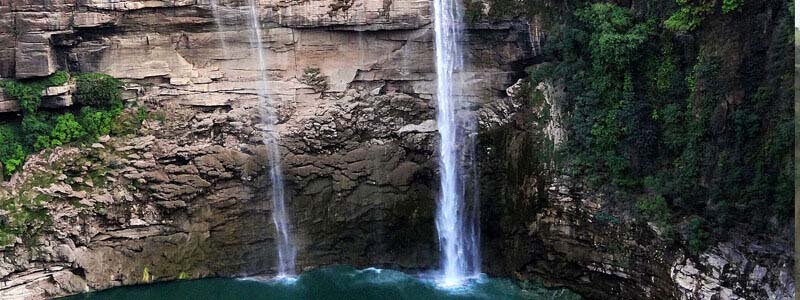
Keoti Falls are located at a distance of 46 kilometers from the district Rewa. The nearest airport to the falls is at Khajuraho. Tourists can explore other attractions of Rewa while visiting the Keoti Falls such as Chachai Falls, Bahuti Falls, Bagheal Museum, PiliKothi, Rewa Fort, VenkatBhavan, Rani Talab and Purwa Falls.
The Keoti Falls are created by the River Mahana, a tributary of the famous river Tamsa or Tons, as it is popularly known as. The Keoti Falls take a plunge from the Rewa plateau, to meet the water below. Keoti Falls form a part of the Chitrakoot hills, which are a part of the Kaimur range of mountains. Due to its location, several adventure sports like trekking, hiking, paragliding, rock climbing, bungee jumping etc can easily be practiced at the falls. The monsoon season is the ideal time to visit waterfalls and same is the case with Keoti. The river is splashing with water, while cascading down the hills.
Rajat Prapat Waterfall
Those seeking adventure will find it in this ten-minute walk over rocks and boulders from Apsara Vihar to the top of Rajat Prapat, the 'big fall'.
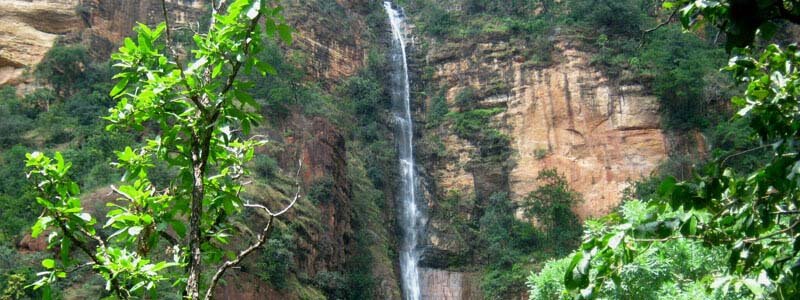
Kapil Dhara Waterfall
Kapildhara waterfall is located in the Amarkantak district of the central Indian state of Madhya Pradesh. It lies at a distance of 6 kilometers from the Narmada Kund. The holy waters of the River Narmada plunge from a height of about 100 feet, from the ground level. This cascade gets its name from the famous sage Kapil, who had resided at this place and performed severe religious austerities. Kapil muni is said to have received the divine light at this very place, according to the ancient scriptures. He had also written ‘Sankhya Philosophy’ an advance treatise on mathematics in the Kapil ashram. Kapildhara is set amidst majestic mountains, dense forests and low lying hills.
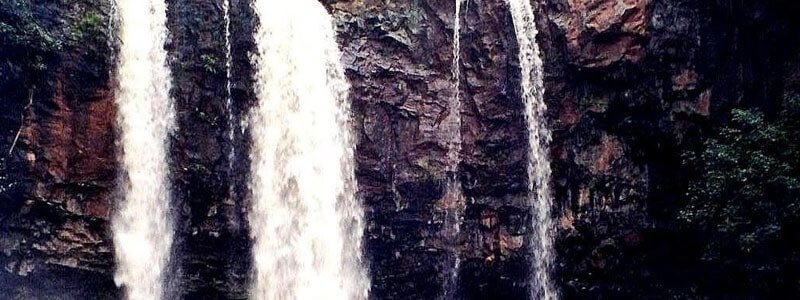
Significance The mountains surrounding the Kapildhara waterfall have several caves within them, where many saints have meditated and attained salvation, during the ancient times. The Kapildhara falls are created by the River Narmada, which originates at the Narmada Kund. Two other rivers Kapila and Erandi, join the Narmada River to form the Kapildhara falls. Though the falls can be visited all year round, the best time however remains the months of September to January, the post monsoon period. En route to the falls, one can come across the Achanakumar Tiger Reserve. The waterfall is prominently set amidst the forests, known as Kapilvan. According to Hindu mythology, sage Kapil had tried to stop the reverse flow of the Narmada River from this point.
First waterfall of Narmada Kapildhara is the first waterfall from the Narmada Kund, on the banks of River Narmada. Though the waters jut down with a tremendous force, the depth of the pool underneath is only 20 to 25 feet. It has become difficult to reach the waters, as the steps that led to them have been washed away by the floods. One needs to beware of the monkeys and langurs that frequent the falls! The people, who visit Kapildhara falls, usually collect the stones from the holy river waters, which are worshipped as shivlings, called Narmadeshwar. The pilgrims also worship the footprints of Lord Kapileshwar Shiva and the sage Kapil, at the Kapil Ashram.
How to reach? Jabalpur is the nearest airport to Amarkantak, at a distance of 245 kilometers. Amarkantak is the origin of the Rivers Narmada and Son. The Kapildhara falls can be reached on foot from Amarkantak. The nearest railway station to the falls is Pendra Road, at a distance of 17 kilometers.
Patal Pani Waterfall
The PatalPani Falls are located in the KekariyaDabri, district of the central Indian state of Madhya Pradesh. The falls are close to Indore city, at a distance of 36 kilometers. The river water swells to dangerous levels during the months of monsoon. It is advisable to take local guidance while visiting the falls and enjoy its beauty with caution. PatalPani Falls are an ideal destination for adventure and nature lovers. A small tea shop is located in the vicinity of the falls; however, one ought to carry food supplies for longer stay at the falls. August and September are the best months to visit the fall as PatalPani becomes almost dry during the summer months.
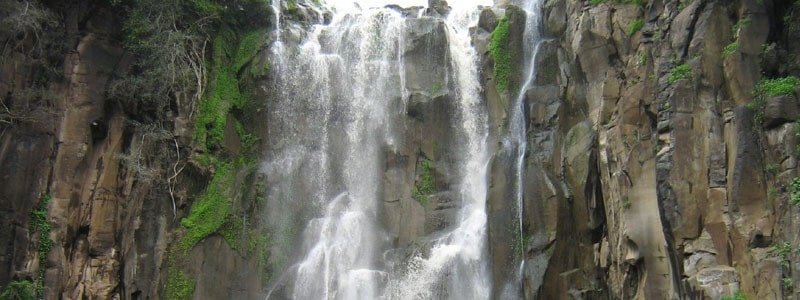
PatalPani Waterfalls near Indore are a famous picnic spot as well as a day out destination for the locals and the tourists visiting the state of MP. The cascade is surrounded by greenery, with dense forests around and a valley to venture! The waters of the cascade end into a kund, which is considered sacred by the local people. The depth of the kund remains unknown and as per the local myths, it is believed to reach ‘Patal’, meaning the hell below ground level. Hence, the name PatalPani was attributed to the waterfall. The monsoon season brings strong flow of water into the cascade, but it still remains the best time to visit PatalPani.
It is advisable not to enter the river waters of PatalPani waterfalls, as the flow of water is not uniform. The uncertain flow of water has caused many a casualties in the area. The currents of the waterfall become stronger after dusk, hence, tourists are not allowed near the cascade at that time. Birds and monkeys can be found loitering around the falls; one can feed them and enjoy their company, feeling close to nature and wildlife. However, the tourists visiting the place do not help in conserving the area and the site at the falls is exposed to littering. Other places of visit near Indore are AhinsaParwat, Patidars, Bhagora, Patel’s Farm and Tope Kund etc.
The nearest rail head to the falls is PatalPani itself. The height of the falls is as high as 300 feet! Trekking and camping activities are undertaken by the tourists visiting the PatalPani waterfalls. However, if one does not comply with the rules set by the care taking authorities of the falls, a tragedy could take place
Dhuandhar Waterfall
The famous waterfall is located just 25 km from Jabalpur. The Narmada making its way through the Marble Rock's narrows down and then plunges in a waterfall known as Dhuandhar or the smoke casade. So powerful is the plunge that its roar is heard from a far distance. The falls and the breaking of the volume of water at the crest present an awesome spectacle of Nature's power unleashed.
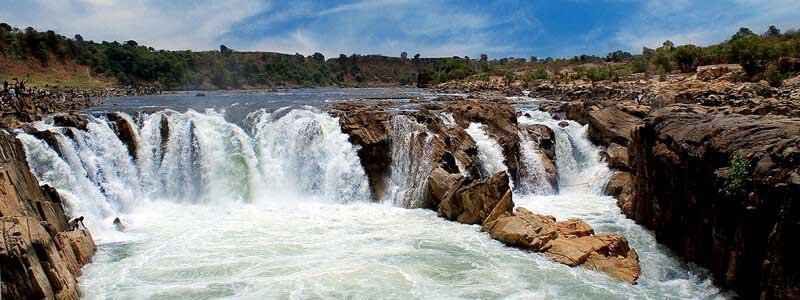
Kukdi Khapa Waterfall
KukdiKhapa waterfall is located in the Chhindwara district, in the heart of India, the state of Madhya Pradesh. This fall is a part of the Sillevani mountainous range. These falls can be witnessed on the Chhindwara-Nagpur route. The descent of KukdiKhapa is around 60 feet from ground level. Usually the local people visit the waterfall for a day long picnic, with friends and family. Other visitors that frequent the waterfall are generally part of tourist plans. KukdiKhapa is equi-distant from Umaranala and Ramakona and hence accessible from both the places. The falls are at their gushing and gurgling best, after the monsoons, with greater currents in the waters!

KukdiKhapa waterfalls are a significant and popular tourist destination. They can be reached by rail from the Chhindwara railway station. The closest aerodrome to the falls is at Nagpur. Madhya Pradesh tourism is gaining momentum and hence the ruling authorities of the state are taking measures to improve the infrastructural facilities in the state.
The location of the KukdiKhapa falls is quite unique, surrounding itself in nature’s full bounty. It is also home to some exquisite species of flora and fauna. The forest area around the falls is thickly wooded, sheltering unique wilderness. The area surrounding the KukdiKhapa falls is not only home to animals, but also inhabited by local tribal people. The tourists can gain insight into their exquisite culture and handmade artifacts. KukdiKhapa is also a small village in the Chhindwara district. Around 700 villagers reside in this small village. The best time to visit the falls is in the months of March to October.
Purwa Waterfall
PurwaFallsPurwa falls are located in the Rewa district of the central Indian state of Madhya Pradesh. The height of the falls is 70 meters above sea level. These falls are originated by the River Tamsa or Tons, as it is popularly known as. River Tons descends down the Rewa plateau to create Purwa Falls. The Purwa falls are a classic example of a nick point, which is caused by rejuvenation. Knick or nick point or casually called as just ‘nick’ is the break in the slopes of the waterfall. The break results in the vertical fall of water, creating a cascade. These falls have a unique water formation.
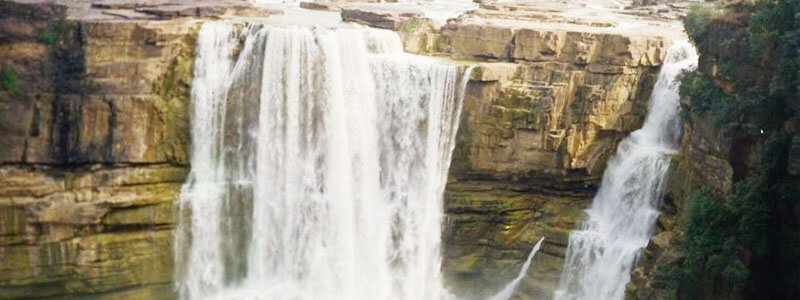
Picnic by the waterfall One can go for a day out or picnic at the Purwa falls, along with friends and family and enjoy a food hamper by the misty waterfall. Purwa Falls are one of the top ten waterfalls of Rewa district. They also have religious significance, as the Purwa falls are located close to several places that have been associated by the Hindu Epic Ramayana. Purwa Falls is also a part of the mighty quadrant of falls of Rewa district. The Purwa falls can be reached from two access points i.e. Satna or Rewa. However, Purwa Falls are less frequented due to the left wing extremism in the forests surrounding the area.
Purwa Falls are located at a distance of 21 kilometers from Rewa district. A holy pilgrimage of Basaman Mama is also in close proximity with the falls. This sacred trip is made by a large number of devotees, who make a stopover at the Purwa Falls too. The four mighty falls of Rewa are quite dangerous and Purwa Falls are one amongst them. Despite many safety measures such as railings and caution boards, mishaps have taken place at these cascades. The cliffs surrounding these falls is a favorite spot of Egyptian vultures that can be found circling above them. The nearest town to Purwa Falls is Semaria.
Jamuna Prapat or Bee Waterfall
spectacular fall in the stream which provides drinking water to Pachmarhi. The bathing pools above the fall are very popular. Bees fall is hardly 2 km. from Jaistambha. This water-stream flows and jumps into the valley to make one of the most beautiful waterfalls of Pachmarhi. Fall makes a sound like thousands of Bees are singing and accordingly called Bees Fall. This spectacular fall leaves long-lasting memory when one stays under its cold, fresh and pure water coming directly from the height of 100 ft. and feel it stroking soothingly on his head.
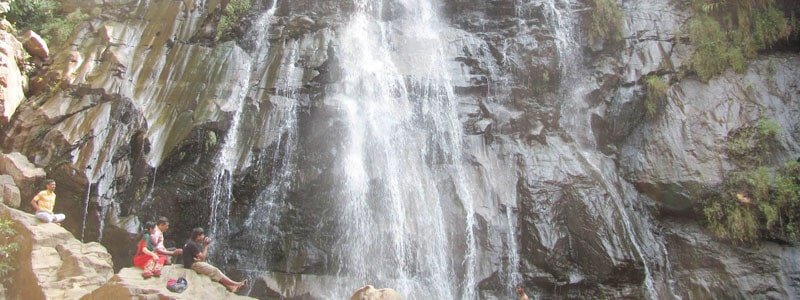
Lilahi Waterfall (Dhanora Falls)
Lilahi waterfall is located in the Chhindwara district of the central Indian state of Madhya Pradesh. They are popularly known as ‘Dhanora Falls’. The Lilahi falls are created by the descent of the River Kanhan, which is the second largest river in the state. One can witness these falls en route to Pandhurna from Mohkhed, through Devgarh. The falls are near Narayan Ghat and Dhanora village. The picturesque waterfalls are surrounded by rock cut mountains and the immense beauty of nature. From the months of July to January, the monsoon and the post monsoon season, the river is at its full bounty, resulting in a heavy flow of the waterfall.
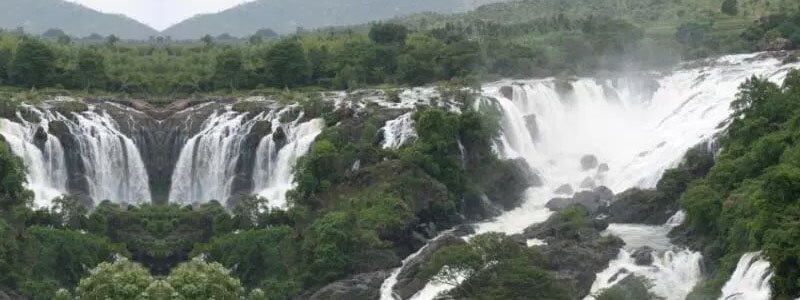
Tourist Attractions Nearby Chhindwara is an important city of Madhya Pradesh, offering a wide range of tourist attractions to choose from. They are: Narayan Ghat, Devgarh Fort, Patalkot, Tamia Hills, GotmarMela of Pandhurna, Tribal Museum, Shashti Mata Mandir, KukdiKhapa waterfalls, Anhoni, Neelkanthi, Hinglag Mata Mandir, Ram Mandir, Jama Masjid and Sahaja Yoga. The most popular amongst them have been explained in detail below:
Weekend Package The Lilahi waterfalls get its name from the village Lilahi, located near the falls. The local people of Madhya Pradesh visit the falls for a day long picnic, along with family and friends, to indulge in family games and relax themselves. It is an ideal destination for a weekend package, combining it with a few other locations nearby. Lilahi falls are accessible by rail from the Chhindwara station and Sonegaon is the closest airport to the falls, at a distance of 118 kilometers from Chhindwara.
A refreshing and adventurous experience is in store at the Lilahi falls.
Duchess Waterfall
Perhaps one of the most awe-inspiring sights in Pachmarhi is the Jalawataran(Cuches Falls).A fast-flowing perennial stream falls over the step cliff-face,above a hundered meters high,into a deep gorge.The sheer mass of water crashing on the rocks gives rise to a deafening roar which can be heard from miles away.
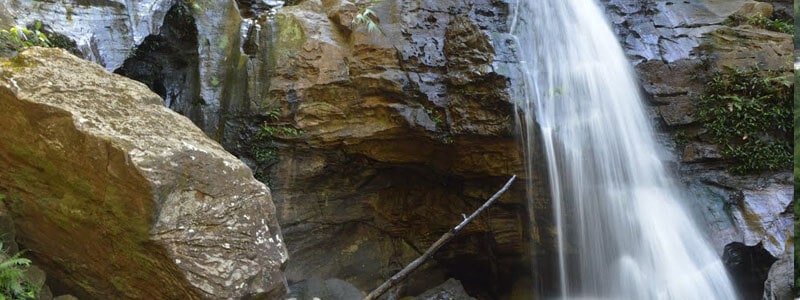
The waterfall comprises of three distinct cascades.A difficult four kilometer trek leads to the base of the first cataract.Here,the air is heavy with spray so fine that it is perpetually misty.The rocks around the waterfall are wet and are hence covered with an assortment of ferns and algae.The bottom of the waterfall is almost inaccessible.The only possible way to get to it is to trek across the valley for over 15 kms across a hostile terrain.
Pandav Waterfall
Pandav waterfalls are located in the Panna district of the central Indian state of Madhya Pradesh. They can be placed en route to Panna from KhaujrahiNahri. The height of the falls is about 30 meters. Though they are not very high, the depth of the lake reaches down to a 100 feet. They are created by a tributary of the river Ken in MP. The falls take a great leap from above and join the river Ken below. It is believed that the Pandavas, of the mythological epic fame Mahabharata, had resided in the Pandava caves, located near the falls. They have believed to have visited the region during their exile period or the Agyaatvaas. The remains of the caves visited by the Pandavas and the shrines can be spotted near the water pool formed at the end of the fall.
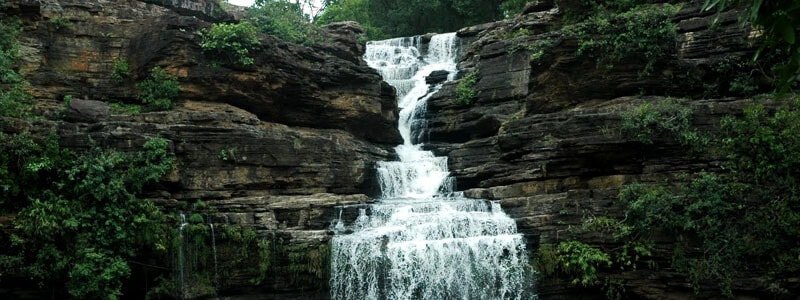
There are no facilities for food around the Pandav falls; therefore it is best to carry food hampers for a picnic at the falls. The place is ideal for an enjoyable family picnic and swimming at the sparkling pool. A steep climb up and down the falls is the prime attraction of the falls, with 166 steps! However, one needs to beware of the monkeys and bears around the falls, as paw marks of the boars can be seen on the trees surrounding the cascade. The Pandav falls are located at a distance of 12 kilometers from Panna. The serenity, purity and mystic atmosphere of the Pandav falls attract both the locals and tourists to this popular spot.
The Pandav falls are not known amongst the tourists and mostly the purity of the place is enjoyed by the locals. Due to this factor, they have remained unexplored and comparatively less littered to the other tourist destinations nearKhajuraho. The falls are however attracting the attention of more visitors as they have several interesting and mythological tales attached to them. The lake that forms at the end of the falls appears to be in a heart shape, giving a romantic feel to the environment. Pandav falls are not very mighty and high, yet they can provide an everlasting experience to its visitors.
According to the local myths, Arjuna had cut a rock by his arrows to create the Pandav Falls. Arjuna trees, named after the warrior prince Arjuna, of the Pandavas, are believed to have medicinal values by the locals. The cool and rejuvenating water and air surrounding the Pandav falls leaves an indelible impression on its visitor. Panna forests provide greenery around the Pandav falls. Lush and green neighboring jungles purify the environment. Local guides are available for the tourists to familiarize them with the area they are visiting. The premises of the falls are well maintained by the local authorities, facilitating the tourists with a clean and green environment. The emerald colored waters of the pool, can be quite inviting to the visitors!
Apsara Vihar Waterfall
Easily accessible from Jai Stambh, this 'fairy pool' is an ideal picnic spot for families with small children, since the pool is shallow, deepening only towards the base of the fall. From Jaistambha reach Pandava Caves and from there, drive less than 1 km. One has to do trekking of 2 km. on hilly tracks. Britishers named this place 'Fairy Pool'. It is an ideal picnic spot. A small charming water-fall of 30 ft. height makes the pool. One must be careful about children and non-swimmers here. Swimmers can enjoy swimming and diving in this natural swimming-pool.
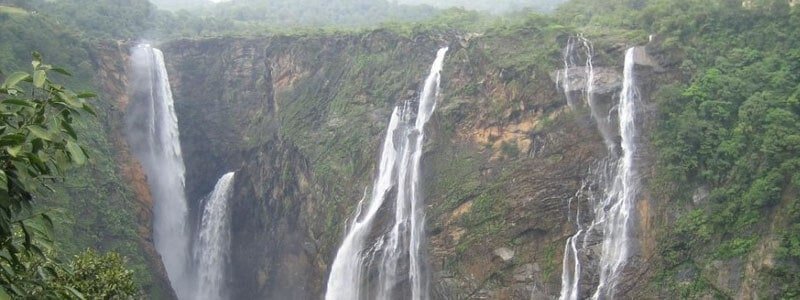
Pawa Waterfall
Pawa waterfalls are located in the Pohri district of the central Indian state of Madhya Pradesh. They lie at a distance of 40 kilometers from Shivgiri. Shivgiri has been named after Lord Shiva of Hindu mythology, as several tales are believed to have taken place in this area, by Shiva. The Pawa waterfalls also descend near a majestic statue of Lord Shiva. The Pawa waterfalls drop into a tank, called the PawaKund, whose depth is about 500 feet. The late months of October to March are suitable for the best view of these falls. The falls originate from the River Pawa and hence named after it.
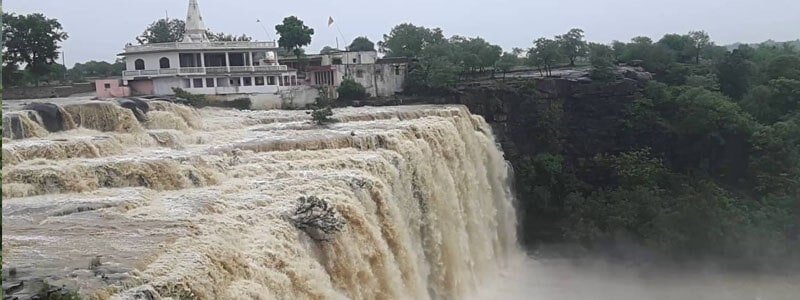
The Shiva Temple A temple dedicated to Lord Shiva is also located near the Pawa Falls, narrating the events that happened there during mythological times. The nearest area inhabited near the Pawa cascade is Shivpuri. The Pawa waterfall is surrounded by low lying hills and greenery, created by the jungles around. These falls have a religious importance attached to them, due to the presence of the Shiva statue in the area. People also visit this location for worshipping the statue of the Lord. According to the local myths, the desires of those visiting this place are fulfilled here. The place is also suitable for recreational activities such as scuba diving and snorkeling. However, only skilled divers with their own personal equipment should attempt at these activities, as there is no facility to provide for the required things near the fall.
Irene Pool Waterfall
This pool was discovered by Irene Bose, wife of Justice Vivian Bose, and named after her. The route upstream leads to a cave, through which the stream goes underground and then over a khud in a series of falls.
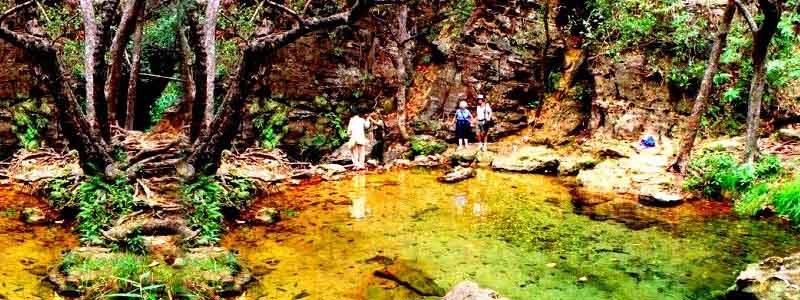
Raneh Waterfall
Raneh Falls is one of the prominent tourist attractions, around 20 Kms away from Khajuraho, which is named after King RanePratap, the erstwhile ruler of the region. Situated in close vicinity of the destination, the waterfall emerged at the confluence of Ken and Khuddar rivers.
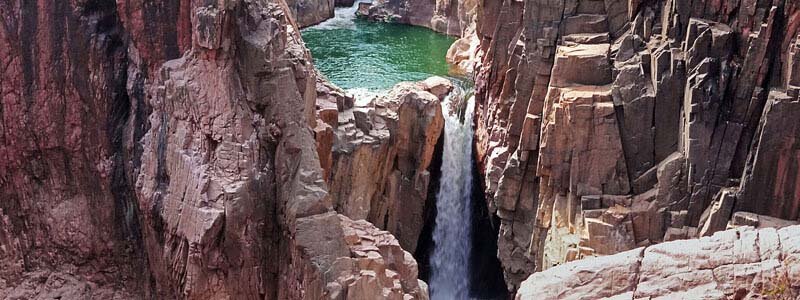
Forming 30 m deep and around 5 km long canyon, the falls flow down at the Ken Gharyal Sanctuary. The surroundings of the falls are adorned with crystalline granite, which is present in varying shades ranging from pink, red and grey. Apart from certain large and small falls that are formed at the assemblage, some seasonal falls also appear during monsoon season.
Sanakua Waterfall
Sanakua waterfalls are located in the Bhind district of the central Indian state of Madhya Pradesh. However, they are also one of the least known attractions of the state. The Sanakua Falls are outlined by green forests, flowing rivers and ancient temples along the way. The Sanakua Falls are compared with the highest falls of the world i.e. the Niagara Falls in Canada. The Sanakua Falls are originated by the river Sindh. Due to its high fall, the water bumping into the pool appears frothy and gurgles along its way. The Sanakua Falls are at a distance of 55 kilometers from the Bhind district.
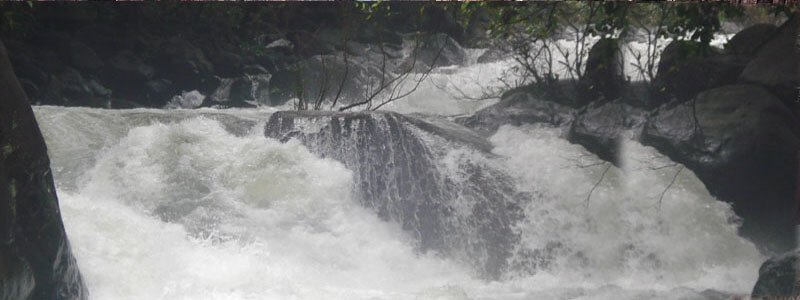
The district of Bhind has been named after the Rishi Bhindi. It lies in the famous Chambal valley, well known for dacoits and bandits. The Rivers Chambal and Sindh is the main rivers of the district. Both the rivers are a tributary of the holy River Yamuna. The climate of the region is usually dry except for the rainy season.
The Sanakua Falls can be placed on the Mau Road. There are around 108 old temples along the River Sindh! They are believed to have been built by gunnies in the span of just one night! Apart from the religious significance of the area, these falls are ideal for recreational activities such as having a family picnic, rock climbing, mountaineering, bird watching, sighting animals and an ideal paradise for nature lovers. The post monsoon months of August to December are the best time to visit the Sanakua waterfalls.
Shambhu Dhara Waterfall
The ShambhuDhara Waterfalls are located in the Anuppur district of the central Indian state of Madhya Pradesh. The water of these falls meets the BaratiNala, 9 kilometers from the famous pilgrimage of Amarkantak. The falls can be spotted amidst the adjoining forests of Amarkantak. ShambhuDhara Falls are not very tall; the height of this cascade is only 35 meters. The origin of the falls is from the place called ShambhuDhara, giving the cascade the name ShambhuDhara Waterfalls. However, this cascade is seasonal in nature and does not flow throughout the year. It is a small trek to reach the falls for the adventure enthusiasts.
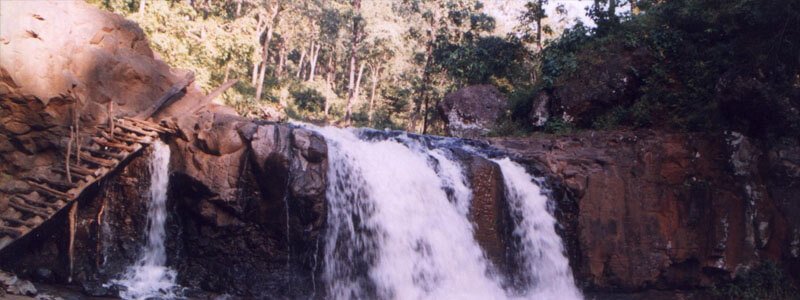
Jabalpur airport is the closest to the ShambhuDhara Falls, at a distance of 246 kilometers. The hotels in Madhya Pradesh available for accommodation are Hotel Chandela, Radisson Blue, UshaBundela, Apna Palace, Sarovar Portico, Fortune Landmark, Ginger, Amrit Residency, Balwas International and Mangalcity. The places of interest in Anuppur, apart from the ShambhuDhara waterfalls are DurgaDhara Falls, KapilDhara Falls, NarmadaMandir, Mai kiBagiya, Bhrigumandal, JwaleshwarMahadev, Sarvodaya Jain Temple and Ganesh Temple. Some of the famous places are explained in detail below:
There is plenty of opportunity for the nature lovers and adventure seekers, who can take up rock climbing, swimming in the water pool beneath the falls and bird watching near the ShambhuDhara Falls and the adjoining forest. However, diving is not permitted at the falls, due to the shallowness of the pool and sharp rocks bedded beneath them. Wildlife sighting is also common in the lush greenery surrounding the falls. The months of June to August i.e. the monsoon months are the only time when one can witness the ShambhuDhara Falls. The nearest railway station to the falls is Anuppur, at a distance of 17 kilometers.
Sultan Garh Waterfall
The Sultan Garh waterfalls are located in the Shivpuri district of the central Indian state of Madhya Pradesh. They can be spotted at a distance of 50 kilometers from the district. Sultan Garh falls are a natural cascade set in between rocky terrain. The river Parvati creates these beautiful falls in Shivpuri. The ideal time to visit these falls is in the post monsoon months of October to March. Both the locals and tourists are found by this fall with their picnic baskets, relaxing in the lap of nature, with friends and family. The area is surrounded by lush green forests, which add to the splendor of the Sultan Garh Falls.

The experience at the Sultan Garh Falls can be very soothing and rejuvenating for the visitor. It is an ideal weekend getaway for the natives of MP state. The hotels available for tourist accommodation near the Sultan Garh Falls are Tourist Village, Son Chiraiya, Delhi Hotel, Tarun Residency and Sanskar Residency. The nearest railway station to the falls is Jhansi, at a distance of 92 kilometers.
The River Parvati is at its natural best, plunging with water and hitting strongly at the vertical rock surface. One can enjoy photography up close with nature and capture the little details of the wilderness, surrounding the region. In short, Sultan Garh Falls and the adjoining area is a feast to the eyes of a nature lover! The sunrise and the sunset are particularly enjoyed by the visitors to this fall, with the sun filling the horizon with its vivid colors. The hills in and around the Shivpuri district have given rise to several beautiful cascades, not to be missed!.